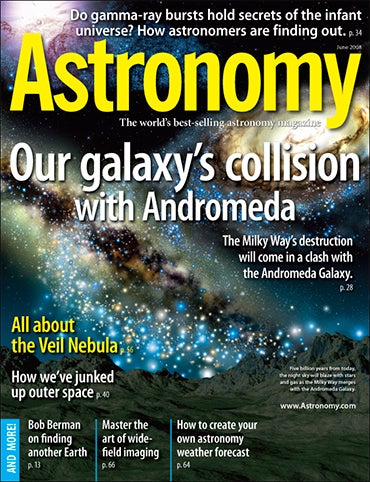
WAUKESHA, WI — Five billion years from now, the Milky Way Galaxy will collide with its neighbor, the Andromeda Galaxy. The combined galaxies — “Milkomeda” — will radically transform the arrangement of stars in Earth’s night sky.
In “Our galaxy’s date with destruction,” authors Abraham Loeb and T.J. Cox use computer simulations to tell the scientists about the coming merger and how it will change our perspective of the universe.
Abraham Loeb is a professor of astronomy at Harvard University, a visiting professor at the Weizmann Institute of Science, and the director of the Institute for Theory and Computation at the Harvard-Smithsonian Center for Astrophysics.
T.J. Cox is a postdoctoral fellow at the Institute for Theory and Computation at the Harvard-Smithsonian Center for Astrophysics.
The June 2008 Astronomy will be available on newsstands May 6.
“How we junked up outer space”
Derelict spacecraft, stray nuts and bolts, and millions of even tinier fragments litter the space around Earth. “How we junked up outer space,” by Astronomy Senior Editor Richard Talcott, discusses how these minute fragments could cause big problems. The amount of junk circling Earth totals thousands of tons. And it poses a significant threat to all functioning satellites, as well as the space shuttle and the International Space Station.
The odds of someone on Earth being injured by a falling piece of debris? About 1 in a trillion. That’s roughly a million times less than the risk of being struck by lightning in the United States.
“Do cosmic flashes reveal secrets of the infant universe?”
Gamma-ray bursts are the brightest flashes in our sky since the Big Bang. Researchers use these luminous explosions to examine the early universe. “Do cosmic flashes reveal secrets of the infant universe?,” by Steve Nadis, describes how astronomers are studying the stars and galaxies these bursts inhabit to learn about the beginning of the universe.
“All about the Veil Nebula”
Located next to the constellation Cygnus the Swan, the Veil Nebula is one of the most challenging and fascinating targets for observers. “All about the Veil Nebula,” by Raymond Shubinski, goes deep inside this celestial object and details how to find it with your scope.
Raymond Shubinski, an Astronomy contributing editor, is director of the Atomic Testing Museum in Las Vegas, an astronomy historian, and a dedicated deep-sky observer.
June night sky events visible without optical aid
- June 7 — The waxing crescent Moon joins Mars, Saturn, and the bright star Regulus at 10p local time.
- June 26-27 — Potential outburst of Boötid meteor shower
Also in the June 2008 Astronomy
- “Another Earth” — Astronomy columnist Bob Berman wonders what it would be like to find a planet like our own.
- “Master the art of wide-field imaging” — Imelda B. Joson teaches you how to become an astrophotography expert.
- “Will you see the stars tonight?” — Learn how to create your own astronomy weather forecast.
- “The sky this month” — Exclusive pullout star charts will guide you through June’s night sky.
- The June issue of Astronomy also includes Astro News, Glenn Chaple’s Observing Basics, Phil Harrington’s Binocular Universe, Stephen James O’Meara’s Secret Sky, New Products, and Reader Gallery.
Astronomy‘s mission:
Astronomy promotes the science and hobby of astronomy through high-quality publications that engage, inform, entertain, and inspire.
More resources from Astronomy.com:
- Astronomy news
- Astronomy basics
- Glossary of astronomical terms
- Return to Astronomy “For the media” page









